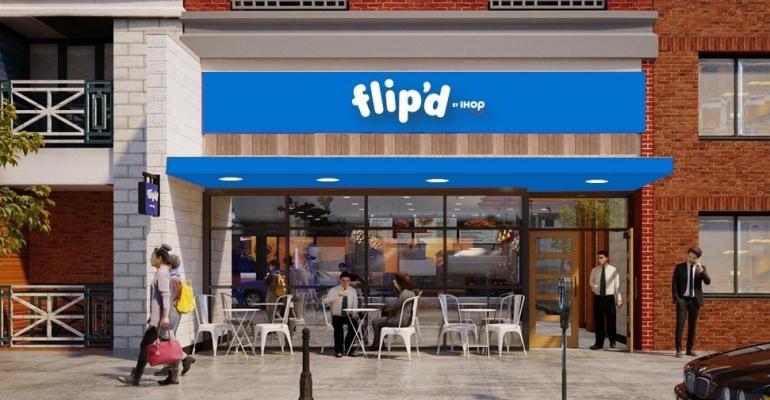Investments in the digital architecture of Applebee’s and IHOP helped drive the recovery for Dine Brands Global during the second quarter despite the still “fluid and unpredictable” environment due to COVID and the Delta variant, the company said Thursday.
Applebee’s two-year comparable restaurant sales increased 10.5% during the June 30-ended quarter. IHOP’s two-year comps were down 3.4%, but that marked a significant improvement over the first quarter this year, when IHOP’s two-year same-store sales were down 21.2%.
John Peyton, Glendale, Calif.-based Dine Brands’ CEO, said he remains cautiously optimistic. Consumer confidence is approaching pre-pandemic levels, and federal spending on infrastructure and low unemployment levels will offer meaningful tailwinds.
Dine Brands has leaned into its scale by investing heavily in building “one common digital architecture” for both brands. “This is the most robust delivery of digital tech in Dine Brand’s history,” he said.
So far in 2021, the company has implemented a new customer relationship management, or CRM, system and a digital platform that enables for more sophisticated marketing and data collection, and serves as the backbone of the brands’ loyalty programs — including a new “very exciting, market-share-stealing” loyalty program for IHOP that will be launched later this year.
The company has rolled out upgrades to the website and apps, and the ordering system is more seamless. Guests can customize digital orders and it takes fewer clicks to navigate the menu, he said. Geofencing tracks guest arrivals and Applebee’s uses a call center using artificial intelligence for automated voice ordering.
In restaurants, hand-held devices for servers in 500 Applebee’s is speeding table turns, and a new kitchen display and point-of-sale system is reducing labor costs, improves order accuracy and integrates the flow of digital and dine-in orders to better support the car-side and to-go business.
Compared with 2019, Applebee’s same-store sales were up 11.7% for April, 8.1% in May and 11.4% in June, said Applebee’s president John Cywinski, and restaurants delivered sales of about $53,000 per week throughout the quarter.
Off-premises sales are shifting to dine-in as consumers return, he said, but the company expects the off-premises sales to settle in the low to mid 20% range — which, for Applebee’s, is about double pre-pandemic levels.
To help keep this business, the chain is expanding its test of drive-thru locations, adding it to six restaurants in the fourth quarter.
Applebee’s has also been experimenting with the virtual brand Cosmic Wings, and had planned to expand with DoorDash. But because of a shortage of wings, that plan is on hold for now, Cywinski said.
IHOP, on the other hand, is jumping onto the virtual brand bandwagon. With underutilized kitchen capacity, particularly during evening hours, IHOP is looking to add one or more virtual brands to restaurants.
Peyton said the company will work with a third-party virtual brand developer to get to market faster and to leverage their expertise, though he declined to reveal which player the company plans to work with. Companies like Virtual Dining Concepts and Nextbite, for example, work with restaurants to find brands that work with existing equipment and ingredients, and targeted dayparts.
IHOP has recovered its breakfast and lunch business to pre-pandemic levels, Peyton said, but sales remains hampered by restaurants that have not been able to open fully. About 85% of restaurants are open for standard operating hours or more, and only about 27% are open 24-hours, seven days. Pre-pandemic, about 50% of IHOP restaurants were open 24/7.
As expected, IHOP’s off-premises sales have also been dipping as dine-in customers return, but brand president Jay Johns said he expects to retain most of the to-go sales growth the brand has earned over the past 15 months, in part because consumers have changed their behavior.
During the second quarter, IHOP’s sales mix included 73.9% dine-in, 13.9% delivery and 12.2% to-go.
Hoping to return to unit growth, IHOP now offers franchisees four platforms for development: the traditional restaurant, as well as a smaller version to be tested this year; nontraditional locations; and the new “conversion friendly” Flip’d by IHOP units — the first two of which will open this year in Lawrence, Kansas, and New York City.
Still, the labor shortage continues to impact wages, hours of operation and supply needs, and inflation is also a concern. Dine Brands is expecting commodity inflation between 4% to 5% for the full year.
“The final unknown is the Delta variant, which is largely regional at this time,” Peyton said. “Our outlook would certainly be impacted if large areas of the country returned to lockdowns or restaurant guests stopped being comfortable dining out.”
Contact Lisa Jennings at [email protected]
Follow her on Twitter: @livetodineout





